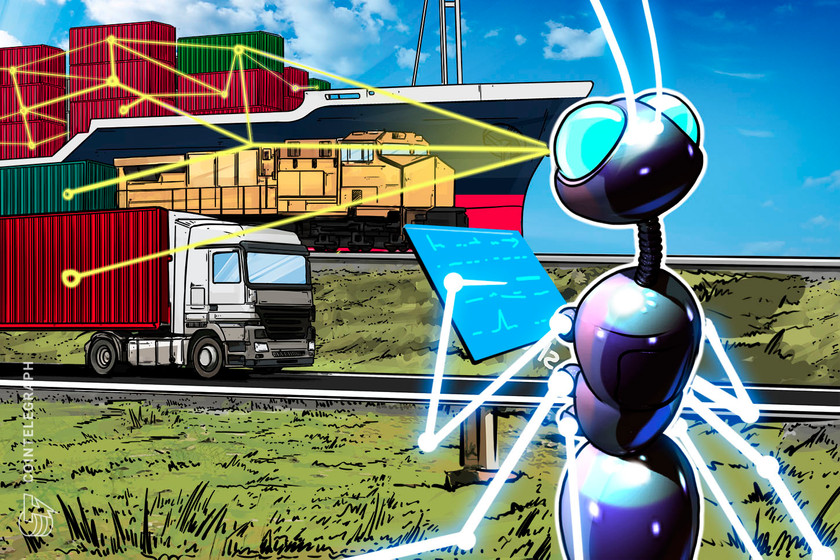- Home
- Supply Chain
Supply Chain
How smart contracts can improve efficiency in healthcare

From insurance to telehealth, smart contracts are finding use cases across the healthcare industry.
Smart contracts are self-executing lines of code that run atop blockchains and are triggered once a set of predetermined conditions are met. They are used to automate the execution of online agreements without the involvement of third parties. Today, they are used across many industries, including the healthcare industry.
The healthcare sector stands to benefit a lot from the widespread implementation of these self-executing programs, especially when it comes to streamlining arduous manual processes, automating bureaucratic procedures and alleviating issues caused by human error.
Today, many healthcare institutions rely on highly centralized conventional management systems to handle sensitive tasks such as record keeping, transactions and correspondences. While some traditional systems can undertake some of the tasks exceptionally well, many of them are prone to failure due to limited interoperability, susceptibility to data corruption and lack of transparency.
The good news is that smart contracts can solve many of these problems.
How smart contracts work
Smart contracts can be programmed to perform a wide range of tasks. They can, for example, be programmed to record payment information on the blockchain once a transaction is made while ensuring that only entities with permissioned access can view the details.
In the healthcare industry, companies can use smart contracts to send out staff salaries, record patient information and notify insurance companies about pending medical bills.
Smart contract programs are usually deployed in compatible runtime environments. On the Ethereum blockchain, for example, smart contract codes are executed via the Ethereum Virtual Machine, which supports the installation of decentralized applications, including smart contracts.
Smart contracts in medical records
Medical records are an essential part of patient management. Smart contracts can be used to create patient profiles on the blockchain while allowing doctors and relevant medical practitioners to view past medical records. This would allow them to come up with better treatment procedures based on a patient’s past treatment history and subsequent outcomes.
Such a setup would save lives and help doctors avoid issues related to medical negligence. Health centers can also configure smart contracts to track health complications arising from treatment side effects and encode them to share the information with partner drug manufacturing companies and medical associations that have yet to uncover the full side effects of new drugs.
It is additionally possible to have smart contracts that send patient information to insurance companies for the purposes of patient compensation claims to smooth out such processes.
Streamlining billing and collection issues
The lack of effective healthcare billing systems can present many challenges to healthcare institutions, especially when it comes to revenue cycle management. Errors related to billing and collections can hinder optimal service in the event that they cause major interruptions.
Trustless blockchain networks incorporating smart contracts can mitigate many of these challenges by ensuring elaborate checklists are implemented to avoid common errors.
Recent: Festivals in the metaverse: How Web3 projects are taking culture virtual
Such systems would be beneficial in situations where there are preexisting transparency issues. The use of multisignature smart contract fail-safes would ensure consensus within management to avoid related problems.
Additionally, the storage of billing information on the blockchain would help to prevent problems related to data loss due to the immutable nature of decentralized ledger networks.
Speed and privacy
Delayed medical information transfers sometimes lead to poor service. Smart contracts have the ability to change this by disseminating patient information across relevant departments in healthcare institutions. Some smart contract systems are able to generate unique anonymized identifiers that can be used to identify each patient without revealing their identity in order to safeguard their privacy.
Moreover, they can be set up to block unauthorized access and, at the same time, allow the scrutiny of the records by personnel, partners and regulators.
The data can also be used for numerous purposes, including clinical research.
That said, smart contracts that manage confidential patient information sometimes require periodic security audits, which can lead to the exposure of sensitive information.
Smart contracts to counter fake drugs
Hundreds of millions of dollars worth of counterfeit drugs find their way into the healthcare industry every year. The bogus drugs cause pharmacies and hospitals to suffer financial losses and sometimes also lead to the death of victims who take them. The flow of these fake medicines is enabled by dysfunctional supply chain systems that are unable to track the origin of supplied drugs.
Healthcare substitutions can use smart contracts to detect fake drugs by confirming supply chain data provided by manufacturers. The implementation of such systems would allow tracking of the drugs using custody logs as they move through the supply chain.
Because the data is stored on the blockchain, which is transparent, healthcare institutions and their suppliers can easily identify supply chain weaknesses that lead to the entry of fake drugs.
Cointelegraph had the chance to speak with Guy Newing, the founder of Immunify.Life, about this problem. His company specializes in the development of secure, self-sustaining blockchain networks for the healthcare industry. According to the executive, there are many ways of countering the issue, including withholding payments for drugs that are not from legitimate sources.
“For instance, a smart contract can be programmed such that retail drug sellers may need to only pay for items received when certain conditions that would have otherwise been tampered with at any point in the supply chain have not been tampered with. This solidifies the integrity of the drugs and healthcare ecosystem as a whole.”
Alex Pipushev, founder of blockchain services company GTON Capital, said that blockchain supply chain systems were evolving at a fast pace and will most likely cater to a wider range of healthcare services as their utility increases.
“Blockchain is a great tool for verification. The healthcare use case is amazing here because you can technically store stamps for each pill set/box in an encrypted way, and anyone who bought it from a pharmacy can verify if legit or fake medicine was sold,” he said.
Smart contracts in other aspects of health
Remote monitoring devices have revolutionized some aspects of telehealth. Today, wearable devices are able to measure important physiological elements such as a patient’s heart rate and transmit the data in real time to healthcare professionals.
Smart contracts have the capacity to not only store such data on the blockchain but also keep it confidential through encryption while ensuring that only intended recipients are able to access it.
The benefits of smart contracts are also becoming apparent in health insurance due to their ability to improve customer experiences.
For example, claims payments handled by smart contracts are typically processed at a faster rate compared to manual procedures, which can sometimes drag on for weeks.
However, there are some limitations when it comes to the use of these technologies in the sector due to constantly changing pre-contractual disclosure obligations, which require some level of human interaction.
The insurance sector is also a regulated market, so there will always be concerns, particularly regarding consumer outcomes. These challenges are further compounded by decisions made by regulators and underwriters that are, in some cases, of an extra-contractual nature.
Recent: What is tokenization and how are banks tapping into its design principles?
As such, smart contracts are presently being used in the sector for impermanent processes such as the confirmation of payments.
Smart contracts have a lot of use cases in the healthcare industry. However, the sector has been slow to embrace the new technology, which has the potential to transform how the industry works.
That said, the healthcare smart contracts market is growing. It was valued at approximately $1.6 billion in 2021 and is projected to breach the 1.78 billion mark in 2022.
Blockchain-based fintech company prepares to enter $500B freight settlement market

Although rare, real-world blockchain utility does exist, now evidenced by one company’s efforts to reduce transactional fees in supply chains.
The world is quick to blame inflation for the rising prices at grocery stores and retailers. This was the #1 political issue for recent Election Day voters in the United States. For example, media sources recently reported poll data that 85% of Americans could not afford to spend $200 on a Thanksgiving meal in November 2022, and only 25% could afford $100.
However, few recognize inflation is only part of the problem. Higher costs for products and services are also directly attributable to settlement fees paid by transportation providers who are forced to take out the equivalent of payday loans against their freight invoices.
Shipper payment terms in the transportation industry are known to be egregious, and most transportation carriers cannot afford to wait 30–180 days to get paid. When a carrier factors, it pledges the collection rights in its accounts receivable to the bank and, in exchange, the bank advances cash in about 10 business days.
By industry averages, this cost to carriers is 3% of every receivable — often escalating up to a 25% annualized interest rate. The bank then waits the 30–180 days and collects directly from the freight shipper. If inflation is thought of as a silent tax, invoice factoring is a second layer of silent taxes on everything we buy.
More than 1 million U.S. trucking companies are factoring 100% of their invoices, and 50% of third-party logistics companies are too. Due to inflation, larger transportation companies are also losing 3% or more of their invoice values when waiting over 60 days to get paid by shippers. These costs create higher freight rates, and the excesses ultimately trickle down to every household and consumer.

Fixing a broken supply chain by settling on the blockchain
TruckCoinSwap (TCS) is a fintech and freight-tech company utilizing a blockchain-integrated mobile app to provide fast and free freight receivables settlement to transportation companies. Moreover, TCS is listed on CrossTower in the U.S. and abroad in 80 countries, and is now also listed on Uniswap.
Chief technology officer Jake Centner explained:
“Centralized exchanges can work very well, and the team couldn’t be more proud of the relationships TCS has made. However, the TCS token must also have a decentralized exchange and non-custodial option in the ecosystem for transportation companies and holders. Uniswap has been the gold standard in this space.”
To that end, TCS has created a process and platform identical to how carriers are settling now, with one added step. A few days after uploading freight documents into the TCS mobile app, a push notification is sent and settlement is made available in the real-time U.S. dollar (USD) value of TCS tokens.
The carrier can then accept settlement via direct deposit from TCS. After receiving the balance in its crypto wallet, the carrier can immediately sell through its exchange market to regain USD liquidity. By taking settlement via TCS, and being able to sell in a matter of minutes, carriers avoid both factoring costs and crypto volatility.
By industry averages, TCS estimates every factoring freightliner can recapture a significant portion of its net revenue. In the supply chain, reducing operating costs makes transportation companies more solvent and applies downward pressure on freight rates. In time, the costs of goods and, more specifically, food prices, can decrease.
Regarding the company’s adoption, CEO Todd Ziegler shared:
“TCS already has truckers involved in the beta, and we were just approached by two more large strategics. One has 223 trucks. The second is one of the largest companies in the U.S. managing freight documents, with over 500,000 transportation users. It speaks volumes that these companies are already interested in integrating with TCS.”
The future of freight and blockchain
Earlier this month, TCS presented its solution at the Future of Freight conference to over 20,000 attendees and has since gained traction in both the crypto and transportation communities with features in FreightWaves, business publications and other related media.
With many strategic relationships already in play, TCS believes it is in a strong position to help carry the transportation industry forward into web3. In looking ahead to the intersection of the two industries, Ziegler offered:
“Following recent court rulings and the acceleration of the DCCPA [Digital Commodities Consumer Protection Act] on Capitol Hill, we’re going to see U.S. crypto exchanges eliminate several coins. Many exchanges are already struggling for revenue and AUM [assets under management], and they’re not going to stick their necks out in the wake of FTX. The projects with no real use case will be the first to go, and the digital assets with value propositions to industry will see greater market share.”
Disclaimer. Cointelegraph does not endorse any content or product on this page. While we aim at providing you with all important information that we could obtain, readers should do their own research before taking any actions related to the company and carry full responsibility for their decisions, nor can this article be considered as investment advice.
How blockchain technology is used in supply chain management?

Blockchain benefits the supply chain industry by enhancing the traceability, transparency and tradability of goods and services that move along the value chain.
The future of blockchain-based supply chain?
The demand for the blockchain-based supply chain is driven by customers’ need to know the specific source of their items and whether they were made according to ethical standards.
Blockchain technology use cases in supply chain management have the potential to address concerns in traditional supply chains, like removing the need to prepare burdensome paperwork. Moreover, a decentralized, immutable record of all transactions and organizations’ digitization of physical assets can make it possible to track products from the manufacturing unit to the delivery destination, enabling a more transparent and visible supply chain.
However, the implementation of blockchain in the supply chain is yet to achieve mainstream adoption as high-level expertise is required to reap the benefits. Additionally, because blockchain technology is still in its infancy, it is governed by various laws in many nations, which would affect supply networks. Despite this, blockchain-based solutions will likely gradually replace conventional supply chain processes and networks; this transition won’t occur all at once.
How blockchain enhances tradability in the supply chain?
Tradability is one of the unique advantages of blockchain technology. Blockchain platforms ensure tradability via the tokenization of assets. Tokenization turns a tangible object, such as a product, into a digital asset, and the system keeps one token for each product, which can be exchanged in the market.
Blockchain platforms help tokenize an asset by dividing it into shares that digitally represent ownership. Users can transfer ownership of these tokens without actually exchanging physical assets because they are tradeable. Moreover, automated smart contract payments help license software, services and products accurately.
In addition, the consensus is provided via blockchain, meaning that there is no disagreement over transactions in the chain by design. The chain’s unique ability to track ownership records for physical assets like real estate and digital assets is made possible because every entity uses the same ledger version.
You might wonder why companies prefer asset tokenization instead of directly paying in fiat. One possible reason is that smart contracts enable peer-to-peer payment that speeds up the transfer of funds, lowering the time it takes to reimburse businesses for goods or services supplied.
Additionally, token payment prevents fraudsters from taking advantage of chargeback situations to steal from businesses. Once a payment is made, it is sent to the business’s blockchain wallet account, and no unapproved withdrawals can be possible.
How blockchain enhances traceability in the supply chain?
To trace the activities along the supply chain more efficiently, concerned parties can access price, date, origin, quality, certification, destination and other pertinent information using blockchain.
Traceability, as used in the supply chain sector, is the capacity to pinpoint the previous and current locations of inventory and a record of product custody. It involves tracking products as they move through a convoluted process, from raw materials to merchants and customers, after passing through many geographic zones.
Traceability is one of the significant benefits of blockchain-driven supply chain innovations. As blockchain consists of decentralized open-source ledgers recording data, which is replicable among users, transactions happen in real-time.
As a result, the blockchain can build a supply chain that is smarter and more secure since it allows for the tracking of products through a robust audit trail with almost concurrent visibility.
By connecting supply chain networks through a decentralized system, blockchain has the potential to enable frictionless movement between suppliers and manufacturers.

Furthermore, producers and distributors can securely record information such as the nutritional value of items, product origin and quality and the presence of any allergens using a collaborative blockchain network. In addition, having access to a product’s history gives buyers more assurance that the items they buy are from moral producers, thus making supply chains sustainable.
On the contrary, if any health concern or non-compliance with the safety standards is discovered, necessary action can be taken against the manufacturer based on the traceability details stored on the distributed ledger.
How does blockchain technology improve supply chain management?
Unlike traditional supply chains, blockchain-based supply chains will automatically update the data transaction records when a change is made, enhancing traceability along the overall supply chain network.
Blockchain-based supply chain networks might need a closed, private and permissioned blockchain with limited actors, in contrast to Bitcoin and other financial blockchain applications, which may be public. However, the possibility of a more open set of partnerships may still exist.
In blockchain-based supply networks, four key actors play roles, including registrars, standard organizations, certifiers, and actors:
- Registrars: They provide network actors with distinct identities.
- Standard organizations: These organizations develop blockchain rules and technical specifications or standards schemes, such as Fairtrade, for environmentally friendly supply chains.
- Certifiers: They certify individuals for involvement in supply chain networks.
- Actors: A registered auditor or certifier must certify participants or actors, such as producers, sellers and buyers, to retain the system’s credibility.

How a product is “owned” or transferred by a specific actor is an intriguing feature of structure and flow management and among the benefits of blockchain in supply chain management. But does blockchain make supply chain management more transparent?
As the concerned parties are required to fulfill a smart contract condition before a product is transferred (or sold) to another actor to validate the exchange of goods or services, and the blockchain ledger is updated with transaction information after all participants have complied with their duties and processes, overall transparency across the value chain is improved.
Additionally, the nature, quantity, quality, location and ownership product dimensions are transparently specified by blockchain technology. As a result, customers can view the continuous chain of custody and transactions from the raw materials to the final sale, eliminating the requirement for a reliable central organization to administer and maintain digital supply chains.
How is the modern supply chain evolving?
Contemporary technologies like artificial intelligence (AI), robotics and blockchain are being incorporated into the digital supply network, which combines data and information from various sources to distribute goods and services along the value chain.
Supply chain infrastructure develops from strictly physical, functional systems to a vast, linked network of assets, data and activities. For instance, by utilizing AI algorithms, businesses may extract insights from large data sets to proactively manage inventory, automate warehouse processes, optimize critical sourcing connections, enhance delivery times and develop novel customer experiences that raise customer satisfaction and increase sales.
In addition, AI-powered robots help automate various human-owned manual tasks, such as order picking and packing processes, delivering raw material and manufactured goods, moving items during storage and distribution and scanning and boxing items. According to Amazon, robots allow it to hold 40% more inventory, enabling it to fulfill Prime shipping commitments on time.
Furthermore, as blockchain is immutable in nature, it can be issued to track and trace the source of products and identify counterfeit items and fraud within the value chain. For instance, if a business is transporting perishables like cheese, which must maintain a specific temperature at all times.
The company transporting the cheese can determine whether the temperature has risen beyond the permitted threshold during the voyage or impacted the cargo, enabling them to minimize problems with food quality.
What is supply chain management and how does it work?
Supply chain management actively streamlines a company’s supply-side operations from planning to after-sales services to enhance customer satisfaction.
Supply chain management (SCM) refers to controlling the entire production flow, from acquiring raw materials to delivering the final product/service at the destination. In addition, it handles the movement of materials, information and finances associated with a good or service.
Even though the supply chain and logistics are sometimes confused, logistics is actually only one part of the supply chain. Traditional supply chain management systems involve steps like planning, sourcing, manufacturing, delivering and after-sales service to control the supply chain centrally.
That said, the process begins with deciding how to meet customers’ needs and selecting suppliers to source the raw material to manufacture the product. The next step is to determine if the manufacturer will outsource or take care of delivery. And after a product is delivered, it is a network that will offer after-sales services, such as handling product returns and repairs, among others, which is crucial for customer satisfaction.

On the contrary, modern SCM systems are managed using software from the creation of goods and services, warehousing, inventory management, order fulfillment, information tracking and product/service delivery to after-sales services. For instance, numerous robotic and automated technologies are used by Amazon to stack and store goods, as well as to pick and pack orders. The company has also begun utilizing electric drones to transport packages weighing less than five pounds in selected United States regions.
European Union Presents Project to Fight Counterfeiting by Using NFTs for 2023
 The European Union (EU) is working on a project that involves blockchain architecture and the use of non-fungible tokens (NFTs) to fight counterfeiting and forgery. The project is the product of several meetings and blockchain hackathons organized by the European Union Intellectual Property Office and proposes to create digital twins of products to trace their […]
The European Union (EU) is working on a project that involves blockchain architecture and the use of non-fungible tokens (NFTs) to fight counterfeiting and forgery. The project is the product of several meetings and blockchain hackathons organized by the European Union Intellectual Property Office and proposes to create digital twins of products to trace their […]ETH Merge will change the way enterprises view Ethereum for business

Industry experts explain how the Ethereum Merge will impact enterprise adoption for business use cases.
A recent report from the Ethereum Enterprise Alliance (EEA) highlights how the Ethereum ecosystem has matured to a point where the network can be used by businesses to solve real-world problems. From supply chain management use cases to payment solutions utilized by companies like Visa and PayPal, the report demonstrates how the Ethereum network has grown to become one of the most valued public blockchains.
Although notable, the EEA report also points out that the rapid growth of the Ethereum ecosystem has created a number of challenges for companies, specifically regarding energy consumption, scalability and privacy. For example, the document states that “sustainability was cited as one of the main concerns, along with transaction fees, in relation to using the Ethereum Mainnet.” The report further explains that the transparency associated with a public blockchain like Ethereum has been a hurdle for enterprises seeking data security and trust.
As such, upgrades such as sharding and layer-2 (L2) scalability solutions remain critical for businesses using the Ethereum network. Yet, the complex nature behind such implementations continues to be difficult for companies to navigate. For instance, the EEA report states that “Many layer 2 solutions and sidechains are relatively new projects, with relatively new technology. They do not necessarily have the track record or proven security and stability of the Mainnet.”
The Merge will change how enterprises view Ethereum
However, industry experts predict that the Ethereum Merge, which is scheduled to take place on Sept. 14, will likely improve enterprise adoption. Paul Brody, global blockchain leader at EY, told Cointelegraph that while the Merge will not affect most enterprise use cases that are presently in use, it will change how businesses perceive Ethereum. He said:
“For years, competing layer-1 networks have talked about how Ethereum can’t get the Merge done. The incredible organizational maturity of Ethereum has been working nicely in the background to do it in a careful and professional manner. As an enterprise, that’s the kind of institutional maturity I want to see.”
Although the Merge has been in development for several years, Brody explained that upgrades on mission-critical infrastructure should never be rushed. As such, he believes that this will remain a key point for businesses using the Ethereum network. “I think future efforts to dismiss Ethereum won’t get much airtime in the post-Merge era,” he said.
While it’s too early to detect how enterprises will react to the Merge, Robert Crozier, chief architect and head of global blockchain at Allianz Technology, told Cointelegraph that his firm will monitor the progress of the Ethereum Merge to see how it stabilizes certain use cases.
Recent: How high transaction fees are being tackled in the blockchain ecosystem
This is noteworthy, as Crozier shared that Allianz has only considered Ether (ETH) and Ethereum-based use cases for experimentation purposes on a small scale. The insurance giant currently uses Hyperledger Fabric and the decentralized ledger platform Corda to streamline cross-border auto insurance claims throughout Europe. Crozier added:
“At Allianz, our International Motor Claims Settlement product utilizes Hyperledger Fabric at its core. We would need to understand and be confident that other protocols like Ethereum would deliver the similar benefits in terms of ease of use, scalability and finality.”
With benefits in mind, Brody explained that the Merge will eventually result in better scalability and privacy for enterprises. “I think we’re heading into a new era of enterprise applications. With both scalability and privacy maturing, it will be possible to address enterprise process needs quite comprehensively in the future,” he said.
Shedding light on this, Ivan Brakrac, senior decentralized finance market strategist at ConsenSys, told Cointelegraph that although the Merge does not directly increase scalability, a number of planned upgrades to Ethereum will address scalability over the next few years.
For example, Brakrac explained that transitioning the Ethereum network from proof-of-work (PoW) to proof-of-stake (PoS) was the first step to enable “shard chains.” As Cointelegraph previously reported, sharding is the act of dividing up a database, or in this case, the blockchain, into various smaller chains known as shards.
“This will reduce network congestion and increase transaction throughput,” Brakrac remarked. This is key for adoption, as Brody shared that EY’s enterprise clients looking at supply chain applications are going to need support for 2–20 million transactions per day. “Pre-Merge Ethereum could not have accommodated this,” he said.
Regarding privacy, a report entitled “The Merge for institutions,” published by ConsenSys on Sept. 5 mentions that L2 solutions also address privacy concerns for enterprises. An increase in L2s will unlock greater privacy mechanisms for business use cases.
For example, Brody explained that EY developed a zero-knowledge proof L2 scaling solution known as Nightfall to handle Ethereum gas constraints and keep fees low. According to Brody, multiple powerful L2 networks will enable different options for enterprises that may require more gas and bigger transactions. He elaborated:
“Privacy starts to unlock a much bigger set of use cases for enterprise users. For example, instead of minting one token that represents a batch of product and gives origin information, I can mint one token for each piece of inventory, and then I can manage specific supply chain inventory levels across a multi-company network on Ethereum.”
In addition to scalability and privacy, sustainability concerns will be addressed once the Merge is implemented. According to Brakrac, Ethereum currently uses an inordinate amount of electricity, noting that the Merge will reduce energy usage by 99%. “This will make Ethereum very sustainable in the long run. By design, this further secures the network and resolves an environmental concern which is net positive from the institutional adoption standpoint,” he said.
Indeed, industry experts believe that sustainability efforts addressed by the Merge will be critical for enterprise adoption. Dan Burnett, executive director of the EEA, told Cointelegraph that while L2s and sidechains have served as bandages on sustainability concerns, large organizations with environmental, social and governance goals tended to shy away from building solutions on Ethereum because of its reputation for being environmentally unsustainable. Yet, he noted that with these concerns being addressed, the Merge may enable the Ethereum business ecosystem to leap ahead.
Yorke Rhodes III, co-founder of blockchain at Microsoft and board member and treasurer of the EEA, further told Cointelegraph that the Merge will put to rest one of the main concerns for enterprises that have a big focus on environmental impact, such as Microsoft.
“This removes one of the key arguments enterprises raise when evaluating whether to build solutions on Ethereum mainnet,” he said. To Rhodes’ point, Crozier mentioned that moving to a more environmentally friendly proof-of-stake mechanism will mean that some enterprises, like Allianz, will take a second look at Ethereum.
Benefits not immediate
All things considered, the Merge will likely increase enterprise interest in Ethereum due to the advancement of the network. Moreover, Rhodes believes that removing the key critique of sustainability will encourage additional movement to the Ethereum Mainnet, even if this is just as a base layer for security. “As a key step in realizing the vision of Ethereum, the ETH merge sets things up for a closer enterprise review sooner rather than later,” he said.
Recent: Mt. Gox creditors fail to set repayment date, but markets to remain unaffected
However, it’s important to point out that the benefits promised by the Merge won’t be seen immediately. According to Brody, it will take at least 12–24 months until privacy-enabled use cases are established following the Merge. He said:
“I hope to see pilots by the end of this year, but feedback loops and infrastructure maturity takes time. Unlike consumer applications, there’s little patience among enterprise buyers for products that don’t work on the first go-round and little willingness to experiment. Enterprise buyers are generally quite conservative, and so the cycle will take longer than consumer users.”
World Gold Council Exec Believes Blockchain Technology Will Bolster Trust in the Gold Industry
 The World Gold Council’s (WGC) head of global sales and regional CEO, Joe Cavatoni, explained on Friday that he believes the gold industry will integrate with blockchain technology in order to “help the industry standardize reporting.” Cavatoni spoke about the London Bullion Market Association’s (LBMA) and WGC’s Gold Bar Integrity Programme (GBI) which aims to […]
The World Gold Council’s (WGC) head of global sales and regional CEO, Joe Cavatoni, explained on Friday that he believes the gold industry will integrate with blockchain technology in order to “help the industry standardize reporting.” Cavatoni spoke about the London Bullion Market Association’s (LBMA) and WGC’s Gold Bar Integrity Programme (GBI) which aims to […]Reports Say Beijing Attacking Taiwan Could Lead to ‘Far-Reaching Economic Consequences’
 While the global economy remains gloomy and the war in Ukraine continues, there’s been significant tension between China and Taiwan. The American representative from California, Nancy Pelosi, plans to visit Taiwan this week and White House officials say China is preparing to carry out “military provocations.” Moreover, during the last few weeks, reports note that […]
While the global economy remains gloomy and the war in Ukraine continues, there’s been significant tension between China and Taiwan. The American representative from California, Nancy Pelosi, plans to visit Taiwan this week and White House officials say China is preparing to carry out “military provocations.” Moreover, during the last few weeks, reports note that […]How blockchain technology can revolutionize international trade

Blockchain technology has proven to be transparent and could make international trade transparent and even more secure.
Since time immemorial, technological innovations have shaped the structure of commerce and trade. The discovery of electricity encouraged mass production and the advent of steam engines ushered in an era of mechanized production.
From information to communication, technology has been used everywhere to make life easier. For this reason, blockchain technology has been tapped by many as the next big thing, considering its use cases which cut across numerous industry verticles.
Mainly used in keeping records of transactions, blockchain technology is a type of distributed ledger technology.
Blockchain makes a difference
According to Statista, blockchain makes keeping data records easier, more transparent, and even more secure. Owing mostly to its resistance to alteration, blockchain offers time-based information on transactions, whether they are between private individuals, corporate entities, supplier networks or even an international supply chain.
It is also a common notion that blockchain is only a technology for Bitcoin (BTC). However, that assumption could not be more wrong. While the technology emerged alongside Bitcoin in 2008, however, today, its use cases have evolved far beyond cryptocurrencies. From finance to e-commerce, food safety, voting exercises and supply-chain management, its applications cut across virtually all sectors of the global economy, including areas directly or indirectly linked to international trade.
The value chain attached to international trade is a notably complex one. While its transactions involve multiple actors, its other aspects like trade financing, customs administration, transportation and logistics all benefit from the adoption of blockchain technology.
According to Statista, cross-border payments and settlements account for the largest use cases of blockchain technology, especially considering how there have been numerous past efforts to digitize trade transactions.
As of today, the potential of blockchain to enhance the efficiency of trade processes is already being explored. For instance, the blockchain project Open Food Chain is working to improve food security via its Komodo Smart Chain.
Recent: Crypto contagion deters investors in near term, but fundamentals stay strong
Kadan Stadelmann, chief technology officer of Komodo — technology provider and open source workshop — told Cointelegraph:
“Blockchain’s biggest advantage is immutability, meaning data can’t be deleted or edited after it’s on the ledger. For international trade, this provides an opportunity for more transparency across several major industries.”
Stadelmann explained that the technology ensures that foods can be tracked from their origin (i.e., a farm in another country) to the consumer’s local supermarket. He says this can help improve food security around the globe by tackling issues like food contamination outbreaks as 600 million — almost 1 in 10 people in the world — fall ill after eating contaminated food and 420,000 die every year, according to the WHO.
Blockchain can streamline the complex documentation processes that are prevalent in international trade. Zen Young, the CEO of noncustodial web authentication infrastructure Web3Auth, told Cointelegraph:
“Digitizing documents for traditional clearance processes, and transactions in international trade can take up to 120 days to complete, but with bills of lading tracked through blockchain, the need for such processes and potential for double spending is eliminated.”
“Transfer payments and transactions are also quicker and cheaper than currently possible through the SWIFT network, blockchain commissions are lower and without maximum limits, which is especially advantageous for exporting goods,” he said.

Furthermore, Zen added that these factors will help fraud reduction through digitally verifiable and legally enforceable non-paper documentation.
In another use case, IBM and Maersk are working on a blockchain-based solution to streamline the global shipping industry. The project, which is called TradeLens, is designed to digitize the entire shipping process on a blockchain.
The ultimate goal is to create a more efficient and transparent supply chain that can speed up delivery times while reducing costs. So far, the project has been successful in onboarding over 150 organizations, including major port operators, shipping companies and logistics providers.
According to IBM, TradeLens has processed over 150 million shipping events and has saved users an estimated 20% in documentation costs. In addition, the platform has reduced the time it takes to ship goods by 40%.
As blockchain continues to gain traction in various industries, it is only a matter of time before its potential is fully realized in the world of international trade. With its ability to streamline processes and reduce costs, blockchain has the potential to revolutionize the way goods are traded around the world.
Despite its promises, however, there are some weak points in blockchain tech’s application to international trade.
Blockchain’s shortcomings
The major disadvantage of using blockchain is the fact that it is often associated with high transaction costs. For example, when it comes to cross-border payments, blockchain technology has been known to be quite expensive.
This is because blockchain transactions often involve multiple intermediaries, which can drive up costs. In addition, the time it takes to settle a blockchain transaction can be quite lengthy, which can also add to the overall cost.
Another disadvantage of blockchain is its lack of scalability. Due to the fact that each block in a blockchain must be verified by all nodes on the network, the system can often become bogged down when handling large volumes of transactions.
This can lead to delays in the processing of transactions, which can be a major issue in the world of international trade.
Finally, according to Deloitte, blockchain technology is still in its early stages of development, which means that it is subject to a number of risks and uncertainties. For example, there could always be the risk that a critical flaw could be discovered in the scalability and privacy framework that could pose an issue to the financial end of the operation.
In addition, there is also the risk that bad actors could exploit vulnerabilities in the system in order to commit fraud or theft. These risks need to be carefully considered by those who are looking to use blockchain technology in the world of international trade.
Recent: Ethereum Merge: How will the PoS transition impact the ETH ecosystem?
Despite these disadvantages, it is important to note that blockchain technology is still in its early stages of development. As the technology matures, it is likely that many of these issues will be addressed and resolved.
As more and more organizations begin to adopt blockchain technology, the overall cost of using the system is likely to decrease. This could make blockchain a more viable option for those who are looking to streamline their international trade operations.
In the end, blockchain technology has the potential to revolutionize the way goods are traded around the world. With its ability to streamline processes and reduce costs, blockchain has the potential to make international trade more efficient and transparent.
Foundry Digital Launches Logistics Arm to Advance Standards in the Cryptocurrency Mining Industry
 On Thursday, Foundry Digital LLC, the mining company and subsidiary of Digital Currency Group (DCG), announced the launch of Foundry Logistics in order to advance standards in the cryptocurrency mining industry. The newly launched arm of the company plans to “bridge the gap between hardware manufacturers and buyers by providing an all-in-one solution for mining […]
On Thursday, Foundry Digital LLC, the mining company and subsidiary of Digital Currency Group (DCG), announced the launch of Foundry Logistics in order to advance standards in the cryptocurrency mining industry. The newly launched arm of the company plans to “bridge the gap between hardware manufacturers and buyers by providing an all-in-one solution for mining […]

